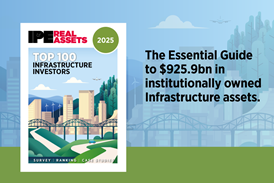Outgoing CEO tells Joseph Mariathasan how the fund is designed to function as a market intervention tool
The UK’s National Wealth Fund (NWF) represents a fascinating paradox in modern economic policy. While it may be seen, in effect, as a ‘sovereign wealth fund’, it has been established by a nation that lacks the traditional prerequisites of massive fiscal surpluses or natural-resource windfalls.
Unlike Norway’s oil-funded behemoth or Saudi Arabia’s petroleum-backed Public Investment Fund, the UK fund emerged from necessity rather than abundance, designed not to park surplus capital but to solve market failures that threaten the government’s industrial ambitions.

The NWF’s origins trace back to the UK Infrastructure Bank, established in 2021 under a Conservative government that was looking to replace EU infrastructure funding lost through Brexit. John Flint, ex-HSBC CEO, was appointed to head the fund and he describes the initial three-year period as focused on building “the ability within the public sector to originate, execute and then warehouse corporate finance and project finance transactions on the public sector balance sheet”.
This foundational work created the institutional capacity to deploy capital flexibly across debt and equity instruments, unencumbered by traditional regulatory constraints.
The transformation from infrastructure bank to national wealth fund occurred swiftly following Labour’s electoral victory in July 2024. By October, the new government had rebranded the institution, reflecting its manifesto commitment to establish a national wealth fund. This transition brought expanded mandates and increased resources, with the organisation set to grow from 300 to 400 employees and receiving enhanced budgetary allocations.
The evolution of objectives represents a significant broadening of scope. While the original mandate focused specifically on financing infrastructure, the new Labour government expanded this to encompass broader industrial strategy support.
Entirely different approach to a sovereign wealth fund
Flint, who is stepping down as CEO this summer, tells IPE Real Assets that there is a fundamental difference between the NWF and traditional sovereign wealth fund models for countries with a “massive current account or fiscal surplus” that need to “reinvest mostly outside of their own market”. The NWF’s approach is entirely different, operating under what he terms an “additionality discipline” – the principle that capital should only be deployed where it is genuinely needed as a result of perceived market failures in key areas of the UK’s economy.
The NWF’s interventions in offshore wind exemplify this approach, explains Flint. “Initially, this was a mature sector with adequate private capital and good returns,” he says when we met recently for coffee at the fund’s offices in London’s Blackfriars. “However, challenging auction rounds made projects uneconomic, creating a role for public intervention to maintain project viability and sector momentum”.
The NWF, says Flint, has the mission of “understanding the government’s industrial policy and strategy, understanding the market, and then going looking for problems”. The fund thus functions more as a market intervention tool than a traditional asset allocation vehicle.
UK chancellor Rachel Reeves in March indicated two strategic objectives for the NWF: “supporting regional and local economic growth and tackling climate change”. This problem-solving orientation for the fund seeks areas where government policy might struggle to achieve implementation due to insufficient private-sector risk appetite.
Earlier this month, the NWF announced it was providing close to half of the £59.6m (€68.5m) of equity investment in carbon-capture project Peak Cluster, which is designed to capture, transport and store CO2 from cement and lime production processes in England.
Clean energy is central to the NWF’s mission, accounting for more than half of current capital deployment. However, the present mandate now encompasses a much broader remit covering areas within the government’s industrial strategy such as advanced manufacturing and defence, while continuing with the existing sectors such as carbon capture and storage, hydrogen technologies, digital infrastructure including fibre broadband, heat networks, electric vehicle-charging infrastructure and local transport solutions.
With capacity to originate 20-35 transactions annually at an average ticket size of £100m, the NWF operates at the wholesale rather than retail scale and targets specific market failures rather than pursuing broad portfolio diversification, making it responsive to changing market conditions and policy priorities. The total notional capacity is £27.8bn, of which approximately £6bn has been committed to date.
This week, it was revealed that the NWF would provide a loan of up to £36.6bn to finance the construction of the Sizewell C nuclear power station, separate to its existing £27.8bn capacity.
Dual-budget structure
More critically, it operates within an economic capital budget of £4.5bn, which Flint expects to increase soon. This dual-budget structure reflects the fund’s unique position; while it can write contracts worth up to £27.8bn, the economic capital budget represents the actual risk exposure or potential losses the Treasury will tolerate, akin to the equity capital of a banking institution that underpins loan activity.
This structure provides operational flexibility while maintaining fiscal discipline. The NWF can take varying risk positions – from 100% capital allocation for early-stage development finance to lower allocations for senior debt participation – but must stay within overall risk parameters.
As Flint puts it, the Treasury’s message is essentially “take as much risk as you want, but don’t come back to us” if losses exceed the economic capital limit. But he is candid about the fund’s limitations when backing venture capital (VC). The organisation wasn’t “built as a VC company”, he explains, and it lacks the appropriate skills and operational framework for systematic venture capital deployment.
While acknowledging consensus concerns about UK venture capital availability, the fund’s £25m minimum investment threshold and wholesale orientation make it unsuitable for traditional VC activities.
The NWF operates within a complex ecosystem of public-sector financial institutions, although mandates have been “carefully crafted so that we don’t overlap with each other”, explains Flint. The closest operational relationship exists with UK Export Finance, the rebranding of the Export Credits Guarantee Department (established in 1919 to promote British exports). This partnership reflects complementary mandates, as demonstrated in their joint financing of the Nissan gigafactory in Sunderland – a project that fits both institutions’ criteria through its clean energy focus and export potential.
Structured approach
The NWF maintains occasional referral relationships with the British Business Bank, while also having limited direct collaboration with entities such as the Low Carbon Contracts Company. This separation by mandate rather than coordination suggests a structured approach to avoiding duplication while maintaining policy coherence across different government financial interventions.
The NWF’s relationship with private capital markets reveals both opportunities and limitations. Flint acknowledges the consensus view that UK capital markets face problems – particularly, the dramatic shift in the UK pension fund allocation from 75% in global equities of which 70% was in in UK equities in 2000 to less than 6% today. However, he expresses scepticism about the scale of the opportunity suggested by the Mansion House Compact, noting that major global players with significant UK presence have not identified compelling investment opportunities that the fund might uniquely address. “We could have a part to play, but what I’m really keen not to do is signal that we are the answer to this problem,” he says.
This tension reflects deeper questions about whether market failures represent genuine opportunity gaps or reflect rational assessments of available prospects. The NWF’s approach focuses on identifying specific situations where “lack of growth capital is holding a good domestic opportunity from fulfilling its potential” though such interventions remain occasional rather than systematic.
The NWF’s success metrics currently remain implicit rather than explicitly defined. Its financial model anticipates eventual profitability, though this remains undemonstrated after four years of operation. The expectation is that mature investments will generate modest returns to taxpayers while delivering policy impact, creating a sustainable model for continued growth, but it is still early days.
The future trajectory appears oriented toward continued growth, with Flint citing Germany’s KfW (Kreditanstalt für Wiederaufbau) as a model of how development finance institutions can evolve into substantial policy tools supporting industrial objectives. But proving the success of the NWF will have to be left to Flint’s successor, Oliver Holbourn, the former chief executive officer of RBS International, who takes over the reins this summer.

Joseph Mariathasan is a contributing editor to IPE, a partner of Peak Sustainability Ventures and a director of GIST Impact


















